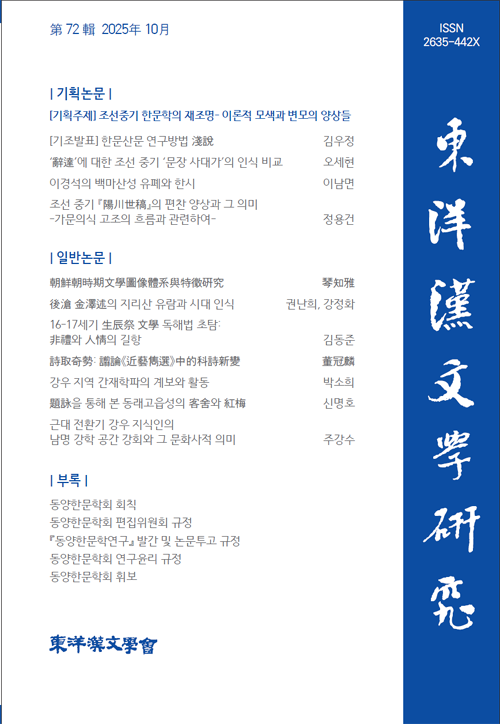- 영문명
- The Cultural Background of Hongmae(紅梅) of the Guest House of Dongnae Old Town Fortress, as Seen Through the Songs of the Goryeo and Joseon Dynasties
- 발행기관
- 동양한문학회(구 부산한문학회)
- 저자명
- 신명호(Myung Ho Shin)
- 간행물 정보
- 『동양한문학연구』第72輯, 289~322쪽, 전체 34쪽
- 주제분류
- 어문학 > 한국어와문학
- 파일형태
- 발행일자
- 2025.10.30
6,880원
구매일시로부터 72시간 이내에 다운로드 가능합니다.
이 학술논문 정보는 (주)교보문고와 각 발행기관 사이에 저작물 이용 계약이 체결된 것으로, 교보문고를 통해 제공되고 있습니다.

국문 초록
고려시대 동래고읍성의 客舍 건물은 正廳과 좌우 翼軒 형태였다. 부속건물 또는 부속시설로는 동익헌 앞뜰의 紅梅. 홍매 앞쪽의 정자와 池塘 및 객사 뒤쪽의 積翠軒이 있었다. 동래고읍성의 객사 배치는 태종 1년(1401) 경 移建된 동래구 동래읍성의 객사 배치이기도 했다.
정청은 마루 즉 廳으로 조성되어 정청으로 불렸다. 반면 동익헌과 서익헌은 온돌방을 중심으로 툇마루에 난간까지 갖춘 軒이었고 적취헌 역시 軒으로서 낮 휴식을 위한 공간이었다.
좌우 익헌의 온돌방은 숙소로 이용되었고 툇마루와 헌은 앞뜰의 홍매, 누각, 지당, 지당 紅蓮, 지당 섬 靑竹 등을 감상하기 위한 시설이었다. 특히 고위 관료가 숙박하는 동익헌의 앞뜰에 홍매, 누각, 지당 등의 경관이 조성되었다. 이 경관은 인빈헌 유숙자의 경관 감상을 위한 조경 시설을 넘어 고려 국왕의 원기 강화를 위한 상징 장치이기도 했다.
고려 왕건 태조는 불교, 도교, 풍수지리를 두루 신봉하였으며 특히 도선 선사의 水母木幹 풍수론을 신봉하였다. 그 풍수론에 따르면 왕건 태조의 조상들이 살아온 송악산은 평양 대동강 물기운으로 자라난 나무였다. 왕건 태조 역시 물기운의 정수를 타고난 나무였다.
이런 배경에서 고려시대 궁중에서는 청색과 홍색이 숭상되었다. 청색은 나무 자체의 색이었고 홍색은 木生火에 따른 상생의 색이었다. 도교에서도 청색과 홍색을 원기, 생명, 재생의 상징 색으로 숭상하였다. 도교의 仙果, 仙藥, 仙酒 역시 청색 아니면 홍색이었다.
반면 金克木에 따른 나무의 상극 색인 백색은 기피되었다. 백색의 李花 나무를 찍어내기 위해 한양에 伐李使를 파견했다는 전설이 생길 정도였다. 고려 궁중의 청색과 홍색 숭상 및 백색 기피는 왕건 태조의 현릉 벽화에 그려진 홍매, 소나무, 대나무에서도 확인된다.
백색 기피 및 청색과 홍색 숭상은 동래고읍성의 객사 조경에도 그대로 적용되었다. 동익헌 앞뜰의 홍매, 정자, 지당, 지당 紅蓮, 지당 靑竹 등은 경관 감상을 위한 조경이자 왕의 원기 강화를 위한 상징 장치이기도 했다. 객사 매화를 백매가 아닌 홍매로 한 이유 역시 도교와 水母木幹 풍수 이론상 왕의 원기 강화를 위한 상징 장치로 홍매가 적합했기 때문이었다.
영문 초록
During the Goryeo Dynasty, the guesthouses of Dongrae Goeupseong Fortress consisted of a main hall and two winged buildings on either side. Ancillary buildings or facilities included a pavilion and pond in front of the Hongmae and Hongmae trees in the front yard of Dongikheon, and Jeokchuiheon behind the guesthouse.
The ondol rooms of the left and right Ikheon served as lodging, while the wooden floor and the wooden railing were designed to provide a view of the red plum blossoms, pavilions, and ponds in the front yard. In particular, the red plum blossoms, pavilions, and ponds were created in the front yard of the Dongikheon, where high-ranking officials resided. The red plum blossoms, pavilions, and ponds were not only landscaped facilities for the Inbinheon guests to enjoy the scenery, but also served as symbolic devices for strengthening the vitality of the Goryeo kings.
Wang Geon, King Taejo of Goryeo, was a devout adherent of Buddhism, Taoism, and feng shui, particularly the feng shui theory of the Buddhist monk Doseon (水母木幹). According to this theory, Songaksan Mountain, where Wang Geon Taejo's ancestors lived, was a tree that grew from the water energy of the Taedong River in Pyongyang. Wang Geon Taejo himself was born with the essence of water energy.
In this context, the colors blue and red were revered in the Goryeo royal court. This is because blue is the color of the tree itself, and red represents the color of mutual growth, based on the principle of wood-fire. Taoism also revered blue and red as symbolic colors of vitality, life, and rebirth. Taoist immortal fruits, immortal medicines, and immortal wines were also either blue or red.
On the other hand, white, the color of wood's antithesis according to the principle of metal overcoming wood, was avoided. Legend even arose that envoys to Hanyang were regularly dispatched to harvest white lily trees. The Goryeo royal court's reverence for blue and red, and its avoidance of white, is evident in the murals of the royal tomb of King Taejo, King Taejo, depicting red plum blossoms, pine trees, and bamboo.
This avoidance of white and the reverence for blue and red were also applied to the landscaping of the guesthouses of the Dongnae Goeupseong Fortress. The red plum blossoms, pavilion, pond, lotus blossoms, and green bamboo in the front yard of Dongikheon served as both scenic landscaping and symbolic devices for strengthening the king's vitality. The reason the guest house's plum blossoms were red, rather than white, was also because, according to Taoist and feng shui theories of water-mother-tree trunks, red plum blossoms were more appropriate as a symbolic device for strengthening the king's vitality.
목차
1. 머리말
2. 동래고읍성의 역사와 관련 자료 검토
3. 동래고읍성 객사의 배치와 池塘
4. 홍매의 의미와 문화적 배경
5. 맺음말
참고문헌
키워드
해당간행물 수록 논문
참고문헌
관련논문
어문학 > 한국어와문학분야 BEST
- ‘밈(meme)’을 활용한 고전문학과 문화콘텐츠의 상호 협력과 융복합교육
- 한국어 쓰기 전략 교육을 위한 생성형 AI 활용 연구
- ChatGPT를 활용한 학술적 글쓰기 사례와 교육 방안 고찰 - H대학교 <논리적 사고와 글쓰기> 강좌를 중심으로
어문학 > 한국어와문학분야 NEW
더보기최근 이용한 논문
교보eBook 첫 방문을 환영 합니다!

신규가입 혜택 지급이 완료 되었습니다.
바로 사용 가능한 교보e캐시 1,000원 (유효기간 7일)
지금 바로 교보eBook의 다양한 콘텐츠를 이용해 보세요!



